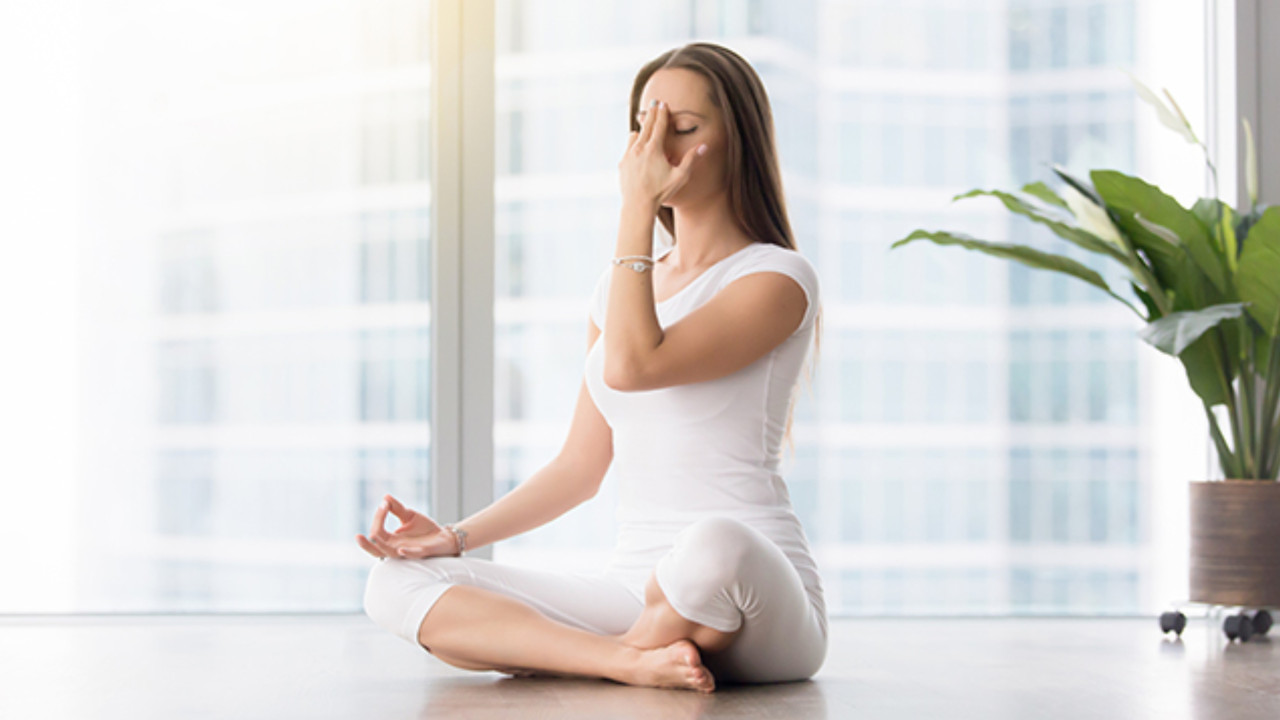Pranayama Yoga: Benefits for Mind, Body and Spirit
Pranayama (pronounced prah-nah-YAH-mah), literally translating from Sanskrit as “life-force (prana) extension (ayama),” is a cornerstone of yoga practice, weaving itself into the very fabric of the discipline. It goes beyond simply taking deep breaths. Instead, pranayama utilizes a series of controlled breathing exercises.
In simpler terms, it’s not just about deep breathing, but rather focused breathing exercises designed to:
- Influence the flow of prana: Pranayama aims to channel and direct prana, the vital life energy believed to course through the body according to yogic philosophy. By controlling the breath, we can influence the flow of this energy, promoting balance and well-being.
- Achieve a state of mental and physical well-being: These exercises can induce relaxation, reduce stress, and improve focus. This holistic approach can lead to a sense of calmness and overall well-being in both the mind and body.
- Prepare the mind and body for meditation: Pranayama helps cultivate a state of inner stillness and heightened awareness, making it an ideal preparation for meditation practice. By calming the mind and regulating the breath, pranayama creates a foundation for deeper meditation.
The Roots of Pranayama
Pranayama originates from ancient India and is a core tenet of yogic philosophy. Prana, translating to “life force” or “vital energy,” is believed to course through the body in subtle channels called nadis.
Ayama signifies “extension” or “control.” So, pranayama literally translates to “life-force extension” or “breath control,” highlighting its role in influencing this vital energy.
Unlike simple deep breathing, pranayama utilizes specific techniques to achieve this influence.
The Roots of Pranayama
Pranayama, a cornerstone of yoga practice, boasts ancient Indian origins. Its very etymology speaks volumes about its purpose.
“Prana,” translating to “life force” or “vital energy,” is believed to course through the body in subtle channels called nadis. Ayama signifies “extension” or “control.”
So, pranayama literally translates to “life-force extension” or “breath control,” highlighting its role in influencing this vital energy. Unlike simple deep breathing, pranayama utilizes specific techniques to achieve this influence.
The Mechanism of Pranayama
While regular breathing is an unconscious function, pranayama techniques involve conscious manipulation of the breath through various elements:
- Length of breath (dura): This can involve short, rapid breaths for invigorating effects, slow and deep breaths for relaxation, or extended breath holds to enhance focus.
- Rate of breath (swara): Pranayama practices can emphasize fast breathing patterns to energize or slow breathing patterns to promote calmness.
- Retention of breath (kumbhaka): In some techniques, the breath is held for a specific duration after inhalation or exhalation, believed to intensify the pranic effects.
- Direction of breath (nadi shodhana): Certain practices involve directing the breath through alternate nostrils, thought to balance the flow of energy within the body’s subtle channels.
By manipulating these aspects of breath, pranayama aims to influence the flow of prana, believed to have a direct impact on our physical, mental, and emotional well-being.
Types of Pranayama
There are numerous pranayama techniques, each with its own focus and benefits. Here are a few common examples:
- Kapalbhati (Skull-Shining Breath): A forceful exhalation technique that invigorates and purifies.
- Bhramari Pranayama (Bee Breath): A humming breath technique that promotes relaxation and calms the mind.
- Nadi Shodhana (Alternate Nostril Breathing): Balances the flow of energy through the left and right nostrils, promoting mental clarity and emotional regulation.
- Ujjayi (Victorious) Breath: A rhythmic breath with a hissing sound, often used during yoga postures to build heat and focus.
- Dirga Pranayama (Three-Part Breath): A simple yet powerful technique that involves deep, full breaths into the lower, middle, and upper lobes of the lungs.
The Mechanism of Pranayama
While regular breathing is an unconscious function, pranayama techniques involve conscious manipulation of the breath through various elements:
- Length of breath (dura): This can involve short, rapid breaths for invigorating effects, slow and deep breaths for relaxation, or extended breath holds to enhance focus.
- Rate of breath (swara): Pranayama practices can emphasize fast breathing patterns to energize or slow breathing patterns to promote calmness.
- Retention of breath (kumbhaka): In some techniques, the breath is held for a specific duration after inhalation or exhalation, believed to intensify the pranic effects.
- Direction of breath (nadi shodhana): Certain practices involve directing the breath through alternate nostrils, thought to balance the flow of energy within the body’s subtle channels.
By manipulating these aspects of breath, pranayama aims to influence the flow of prana, believed to have a direct impact on our physical, mental, and emotional well-being.
The Benefits of Pranayama
The practice of pranayama offers a multitude of benefits, weaving its magic across various aspects of our being:
- Physical benefits: Improved lung function, increased oxygen intake, detoxification of the body, stress reduction which can bolster the immune system, and regulation of blood pressure, leading to a healthier cardiovascular system.
- Mental benefits: Enhanced focus and improved concentration for sharper cognitive function, reduced anxiety and depression for a more balanced mind, better sleep quality promoting overall well-being, and heightened self-awareness for a deeper understanding of oneself.
- Spiritual benefits: Awakened spiritual potential through the connection of breath and consciousness, a deeper connection with the inner self for a sense of peace and tranquility, and preparation for meditation by calming the mind and creating a foundation for inner exploration.
Pranayama: A Guide for Beginners
Intrigued by the potential of pranayama to elevate your well-being? Here’s how to take the first steps:
- Seek Guidance: A qualified yoga teacher or pranayama instructor can be your compass. They’ll ensure you learn proper techniques, select practices tailored to your needs and experience level, and answer any questions that arise.
- Begin Gently: Like any new skill, start slow and simple. Choose short, easily mastered techniques and gradually increase the duration and complexity as you gain comfort and confidence.
- Embrace Consistency: Regular practice is the key to unlocking the full potential of pranayama. Even a few minutes dedicated daily can yield significant benefits. Consistency builds upon the foundation you’ve laid, deepening the impact on your mind, body, and spirit.
Remember, pranayama is a powerful tool for enhancing your overall well-being. By incorporating it into your routine, you can cultivate a healthier body, a calmer mind, and a more connected spirit.
So, take a deep breath, embark on your pranayama journey, and discover the transformative power within your own breath.
Benefits of Pranayama on Body Mind and Spirit
Pranayama, the yogic art of breath control, extends far beyond simply taking deep breaths. It’s a practice with the potential to create a ripple effect throughout your entire being, impacting your physical, mental, and spiritual well-being.
On the Physical Plane:
- Enhanced Lung Function: Pranayama exercises can strengthen the respiratory muscles and improve lung capacity, allowing for deeper breaths and more efficient oxygen intake.
- Detoxification: Certain pranayama techniques can stimulate the body’s natural detoxification processes, promoting the elimination of waste products.
- Stress Reduction: By calming the nervous system, pranayama helps manage stress hormones, leading to a lowered blood pressure and a more relaxed state.
- Boosted Immunity: Reduced stress and improved detoxification can contribute to a stronger immune system, better equipped to fight off illness.
- Cardiovascular Health: Pranayama practices can regulate blood pressure and heart rate, promoting a healthier cardiovascular system.
On the Mental Plane:
- Sharpened Focus: Pranayama can enhance concentration and focus by calming the mind and reducing distractions.
- Reduced Anxiety and Depression: Pranayama’s stress-relieving effects can alleviate symptoms of anxiety and depression, promoting a more balanced mental state.
- Improved Sleep Quality: By calming the mind and body, pranayama can contribute to better sleep quality, leaving you feeling more refreshed and energized.
- Heightened Self-Awareness: The focused breath in pranayama can bring increased awareness of your thoughts and feelings, fostering a deeper understanding of yourself.
On the Spiritual Plane:
- Awakened Potential: Pranayama is believed to awaken the body’s subtle energy channels, potentially leading to a sense of heightened awareness and spiritual connection.
- Inner Peace: The calming and focusing effects of pranayama can cultivate a sense of inner peace and tranquility.
- Meditation Preparation: Pranayama practices can prepare the mind and body for meditation by promoting stillness and focus.
The impact of pranayama is multifaceted, weaving its influence across the physical, mental, and spiritual aspects of our being.
By incorporating this practice into your routine, you can embark on a journey of transformation, cultivating a healthier body, a calmer mind, and a more connected spirit.
Additional Considerations
Finding the Right Technique: The world of pranayama offers a vast array of techniques, each with unique benefits and areas of focus. Consulting a yoga teacher or pranayama instructor can be invaluable.
They can guide you towards practices that align with your specific needs and goals, ensuring you derive the maximum benefit from your practice.
Gradual Progression: As with any new physical or mental endeavor, approaching pranayama gradually is key. Begin with short, easily mastered techniques and gradually increase the duration and complexity as your comfort and confidence grow.
This steady progression allows your body and mind to adapt and integrate the practice effectively.
Consistency is Key: The true magic of pranayama unfolds with consistent practice. Even dedicating a few minutes daily to pranayama can significantly enhance your well-being.
Consistency builds upon the foundation you’ve laid, deepening the impact on your mind, body, and spirit. Remember, pranayama is a journey, not a destination. Embrace the practice with patience and enjoy the transformative process.
By incorporating pranayama into your life, you embark on a journey of self-discovery and transformation.
It’s a practice that nourishes the body, calms the mind, and awakens the spirit, leading you towards a more fulfilling and vibrant existence.
Frequently Asked Questions (FAQs) on Pranayama
1. What is Pranayama?
Pranayama is a yogic practice that involves the conscious regulation of breath to enhance physical, mental, and spiritual well-being. It is a key component of traditional yoga, focusing on controlled breathing techniques.
2. Why is Pranayama important?
Pranayama is essential for various reasons. It improves respiratory function, promotes relaxation, reduces stress, and plays a pivotal role in harmonizing the flow of vital life force energy (prana) throughout the body.
3. How do I get started with Pranayama?
Beginners can start with simple breathing exercises like diaphragmatic breathing. As you progress, explore different techniques under the guidance of an experienced instructor to ensure proper practice.
4. Can anyone practice Pranayama?
Yes, Pranayama is generally accessible to people of all ages and fitness levels. However, individuals with specific respiratory or cardiovascular conditions should consult a healthcare professional before starting a Pranayama practice.
5. How often should I practice Pranayama?
The frequency of Pranayama practice varies. Beginners may start with a few minutes daily and gradually increase the duration. Consistency is key, but it’s essential to listen to your body and practice within your comfort level.
6. What are the benefits of Pranayama?
Pranayama offers a range of benefits, including improved lung capacity, stress reduction, enhanced focus, and a deeper connection between mind and body. It is also believed to contribute to spiritual growth and heightened awareness.
7. Can Pranayama help with stress and anxiety?
Yes, Pranayama is known for its stress-relieving properties. Techniques such as alternate nostril breathing and deep abdominal breathing can have a calming effect on the nervous system, reducing stress and anxiety.
8. Are there any precautions for Pranayama?
Individuals with respiratory conditions, pregnant women, or those with specific medical concerns should consult a healthcare professional before starting a Pranayama practice. It’s crucial to practice under proper guidance, especially if you’re new to yoga.
9. Can Pranayama be practiced alone, or is supervision necessary?
While basic Pranayama techniques can be practiced independently, it’s advisable, especially for beginners, to learn from a qualified instructor. Supervision ensures correct techniques, posture, and progression in your practice.
10. How long does it take to experience the benefits of Pranayama?
The timeline for experiencing benefits varies. Some people may feel immediate effects, such as increased relaxation, while others may notice cumulative benefits over time. Consistent practice and patience are essential for optimal results.

























